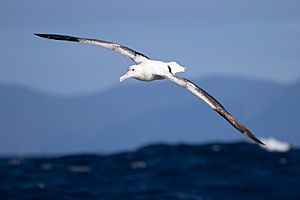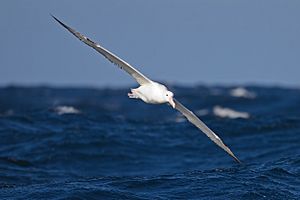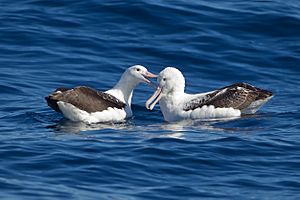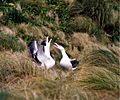Southern royal albatross facts for kids
Quick facts for kids Southern royal albatross |
|
|---|---|
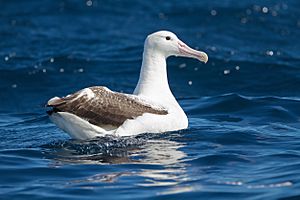 |
|
| East of Tasmania | |
| Conservation status | |
| Scientific classification | |
| Genus: |
Diomedea
|
| Species: |
epomophora
|
The southern royal albatross (Diomedea epomophora) is a very large seabird. It belongs to the albatross family. With a wingspan of over 3 meters (10 feet), it is one of the two biggest albatross species. The other is the wandering albatross. Some studies suggest the southern royal albatross might be a bit heavier than the wandering albatross. They both have similar wingspans.
| Top - 0-9 A B C D E F G H I J K L M N O P Q R S T U V W X Y Z |
About Albatrosses
Albatrosses are part of a bird group called Procellariiformes. This group also includes shearwaters and petrels. These birds have special features. For example, they have unique nose tubes called naricorns on their upper beak. An albatross's nostrils are on the sides of its beak.
Their beaks are also special. They are made of 7 to 9 hard plates. Albatrosses can also make a special "stomach oil." This oil is stored in their stomach. They use it to protect themselves from predators. It's also a rich food source for their chicks and for adult birds during long flights.
The southern royal albatross was once thought to be the same species as the northern royal albatross. Together, they were just called the "royal albatross." Now, most scientists agree they are two different species.
Bird Name Meaning
The name Diomedea comes from Diomedes. He was a character in ancient Greek stories. His friends were said to have turned into birds.
What They Look Like
The southern royal albatross is about 112 to 123 centimeters (44 to 48 inches) long. It weighs around 8.5 kilograms (18.7 pounds) on average. Male albatrosses are usually 2 to 3 kilograms (4.4 to 6.6 pounds) heavier than females. Their wingspan is typically between 2.9 and 3.28 meters (9.5 to 10.8 feet). Some can even reach about 3.51 meters (11.5 feet).
Young albatrosses have a white head, neck, and belly. Their wings are dark brown or black with white spots. Their tail is white with a black tip. As they get older, the black on their tail and back fades. White patches slowly appear on their upper wings.
All southern royal albatrosses have a pink beak. It has a black line along the top edge. Their legs are flesh-colored. It can be tricky to tell young southern royal albatrosses apart from northern royal albatrosses.
They look different from the wandering albatross. Southern royals have a very clean black and white look. Wandering albatrosses often have a peachy spot on their neck. Most wandering albatrosses also have dark feathers on their tail and head. The white on the southern royal's wing spreads out from the middle in larger patches. The southern royal albatross can live for about 58 years.
Where They Live
| Location | Population | Date | Trend |
|---|---|---|---|
| Campbell Islands | 8,200-8,600 pair | 1997 | Stable |
| Enderby Island | 69 pair | 2001 | Stable |
| Auckland Island & Adams Island | 20 pair | 2001 | Stable |
| Total | 28,000-29,500 | 1997 | Stable |
Most southern royal albatrosses live in the southern oceans. You can find them between 30° S and 45° S latitude.
The largest group of these albatrosses nests on Campbell Island. This island has no rats, which is good for the birds. About 8,200 to 8,600 pairs live there. Smaller groups nest on Adams Island and Auckland Island. Some also live on Enderby Island. You can also find some mixed-species birds (hybrids) in New Zealand on the Otago Peninsula. They fly along the coasts of southern South America and around New Zealand.
Behavior
Feeding Habits
The southern royal albatross mainly eats squid and fish. They also eat small amounts of dead animals, crustaceans (like crabs), and salps.
They usually search for food within 1,250 kilometers (777 miles) of their nesting site. Even though they travel far, these albatrosses tend to look for food in shallower waters. They also stay closer to the edges of continents than wandering albatrosses do.
Reproduction and Life Cycle
Southern royal albatrosses like to build their nests in grassy areas, on flat tops of hills, or on ridges. They lay one egg every two years. This usually happens in November or December. Both parents take turns sitting on the egg. They also both help raise the chick. Very few eggs are lost once the parents start nesting. When feeding their young, they fly south to the Campbell Plateau and north to the Chatham Rise.
Conservation Status
The IUCN says this bird is a vulnerable species. This means it faces a high risk of becoming extinct in the wild. They live across a huge area of 63.4 million square kilometers (24.5 million square miles). Their breeding areas cover about 750 square kilometers (290 square miles). In 1997, there were an estimated 28,000 to 29,500 birds.
Since they are at the top of their food chain, they have very few natural enemies. However, large fishing boats are a big problem for all albatrosses.
The number of southern royal albatrosses is slowly growing again. It had dropped a lot in the late 1800s and early 1900s. By the 1880s, they had disappeared from Auckland Island and Enderby Island. Pigs and cats on Auckland Island still cause problems by eating chicks and eggs. Longline fishing is a major threat. Also, a type of scrub plant called Dracophyllum is growing too much. This takes away space where the albatrosses can nest.
Gallery
-
Off Kaikoura, New Zealand
Images for kids
See also
 In Spanish: Albatros real para niños
In Spanish: Albatros real para niños



